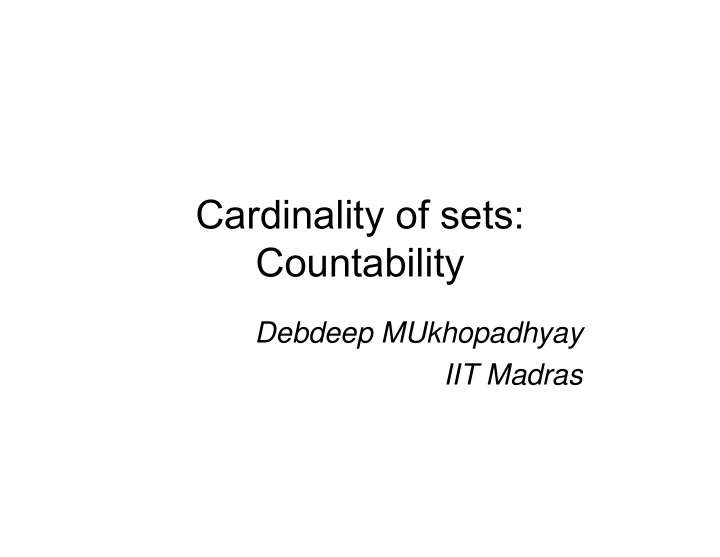

Cardinality of sets: Countability Debdeep MUkhopadhyay IIT Madras
How do we count? • The property of natural numbers are used to measure the size of a set. • Also in comparing the size of two sets. • How do we count the number of books in a shelf? – We essentially establish a one-one relation between the objects to be counted and the set of positive integers.
Can we generalize this concept? • Two sets A and B are said to be equipotent, and written as A~B iff there is a one-one and onto correspondence between the elements of A and those of B. They are defined to have the same “cardinality”. • Example: Let N={0,1,2,…} and N 2 ={0,2,4,..}. Show that N~N 2 . – Define, f:N � N 2 , as f(n)=2n, n is in N. The function is a one-one and onto correspondence and hence the result. Note than N 2 is a subset of N.
Another example • Let P be the set of all positive real numbers and S be the subset of P given by S={x|x is in P AND 0<x<1}. Show that S~P • Define f:P � S as f(x)=x/(1+x) for x in P – Range is in S. – One-one: f(x)=f(x’)=>x=x’ – Onto: For any y in S, we have x=y/(1-y) which is in P. (Note y=1 is not defined in S) • Remember the mapping is not unique. What is important is that a mapping exists.
Finite Sets • A set is finite when its cardinality is a natural number. Any set which is not finite is infinite. Thus to prove that a set is finite we have to discover a bijection between the set {0,1,2,…,n-1} to the set. (useful to prove a set is finite) • A set is infinite when there is an injection, f:A � A, such that f(A) is a proper subset of A. A set which is not infinite is finite. (useful to prove a set is infinite)
Set N of natural numbers is infinite. • To apply the first definition, we have to show that there is no bijection from the set {0,1,2,…,n-1}. Let k=1+max{f(0),f(1),…,f(n-1)} • Clearly, k ≠ f(x), for any x chosen from the set {0,1,2,n-1}. • But k is in N. • So, f is not a surjection and hence not a bijection. Since, n and f are arbitrary, N is infinite.
Set N of natural numbers is infinite. • To apply definition 2, it is easier because the proof is existential. • We have to discover any injection from N to N, such that f(N) is a proper subset of N. • Propose f:N � N, as f(x)=2x. This is an injection whose image is a proper subset of N. The image is the set of even integers.
Prove the set of R is infinite. • Define f:R � R, – f(x)=x+1, if x >= 0 – Else, x – f(R)={x|x Є R Λ x is not in [0,1)} Prove that the closed interval [0,1] is infinite The function f: [0,1] � [0,1] is defined by f(x)=x/2. Clearly, this is an injection whose image is a proper subset of [0,1]
Denumerable Sets • Any set which is equipotent to the set of Natural numbers is called countable or denumerable. • That, is there has to be a bijection from N to the set. • Then the set can be either finite. • Or, it can be what we know as countably infinite.
Prove that I is countably infinite. • Exercise to prove that it is infinite. • Countably infinite we require an enumeration , such that we show that there is a bijection from N to I. • 0 1 2 3 4 5 6… (the Natural Numbers) • 0 -1 1 -2 2 -3 3… (the integers)
Show that the set N χ N is countable <0,2> <0,3> …. <0,0> <0,1> <1,0> <1,1> <1,2> <1,3> …. <2,0> <2,1> <2,2> <2,3> …. <4,0> <4,1> <4,2> <4,3> …. …. …. …. …. The bijection: f(0)=<0,0>, f(1)=<0,1>, f(2)=<1,0> and so on…
Theorem • An infinite subset of a denumerable set is also denumerable. • Hence, Q + is a denumerable set. As it is an infinite subset of N χ N such that if <m,n> belongs to the set there is no common factor between m and n, except 1.
The set of real number [0,1] is not countably infinite. • We have seen it to be infinite. • Each x in [0,1] can be expressed as an infinite decimal expansion: – x=.x 0 x 1 x 2 ... • Trying in the same way for a bijective map from N to the set [0,1]: – f(0)=.x 00 x 01 x 02 … – f(1)=.x 10 x 11 x 12 … – f(2)=.x 20 x 21 x 22 … – … • Now write a y=.y 0 y 1 y 2 … such that y i =1 if x ii ≠ 1 and =2 if x ii =1 • Note y is in [0,1] but is different from each of f(n) in at least one bit, namely the nth digit. Thus f:N � [0,1] is not surjective. Thus the set is not countable.
• This technique is called “Cantor diagonalization technique” and is one of the three fundamental proof techniques. The other two being mathematical induction and pigeon hole principle.
Assignment (5 marks) 1. Prove that {0,1} * is a countable infinite set. 2 marks 2. Prove that 2 {0,1}* is not countable using the Diagonalization method. 3 marks
Recommend
More recommend